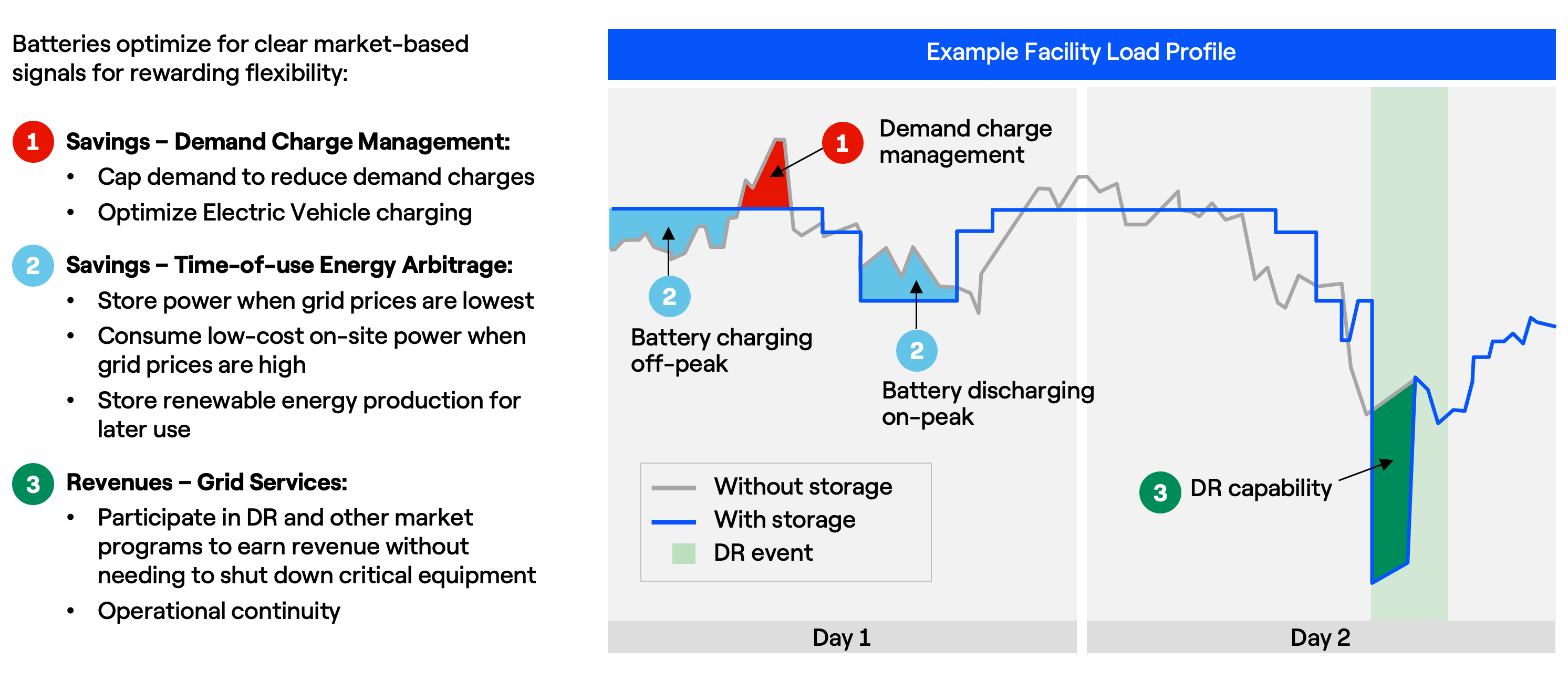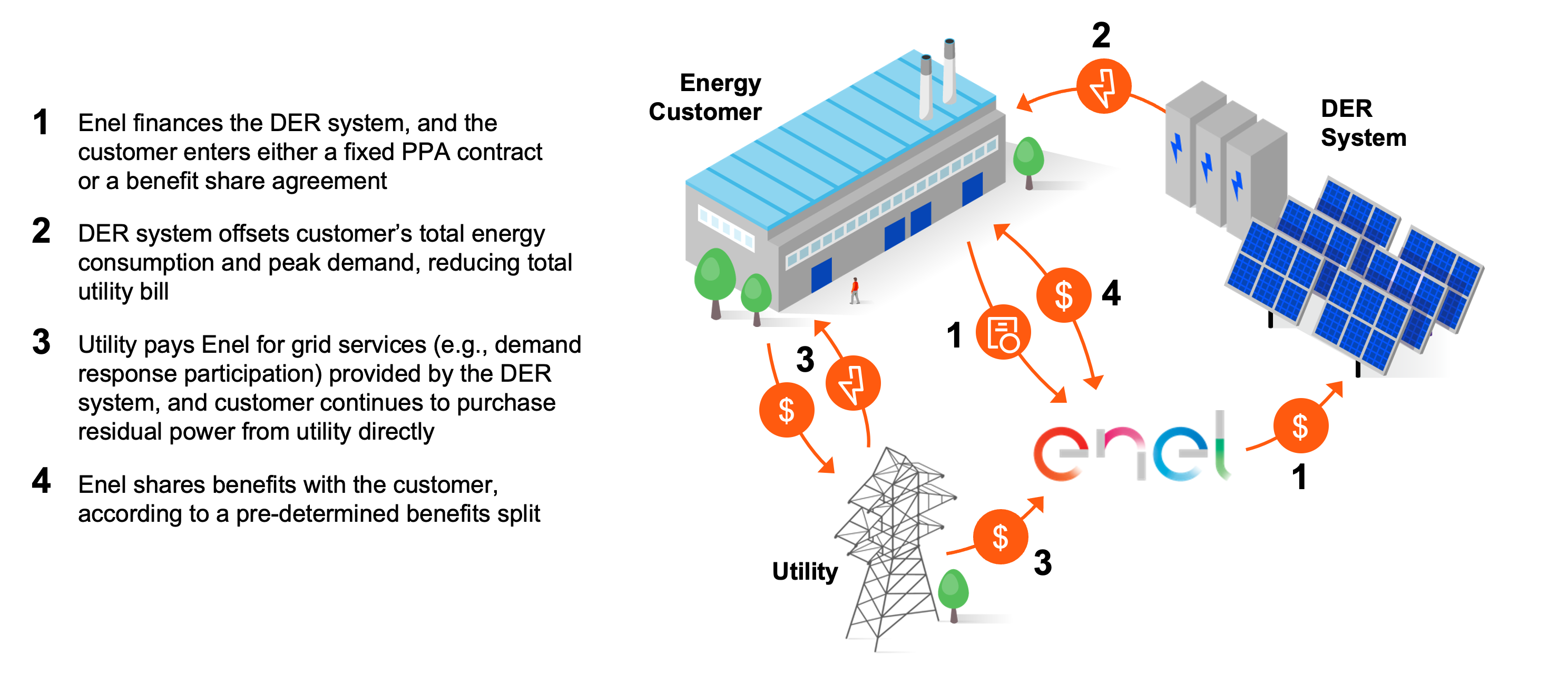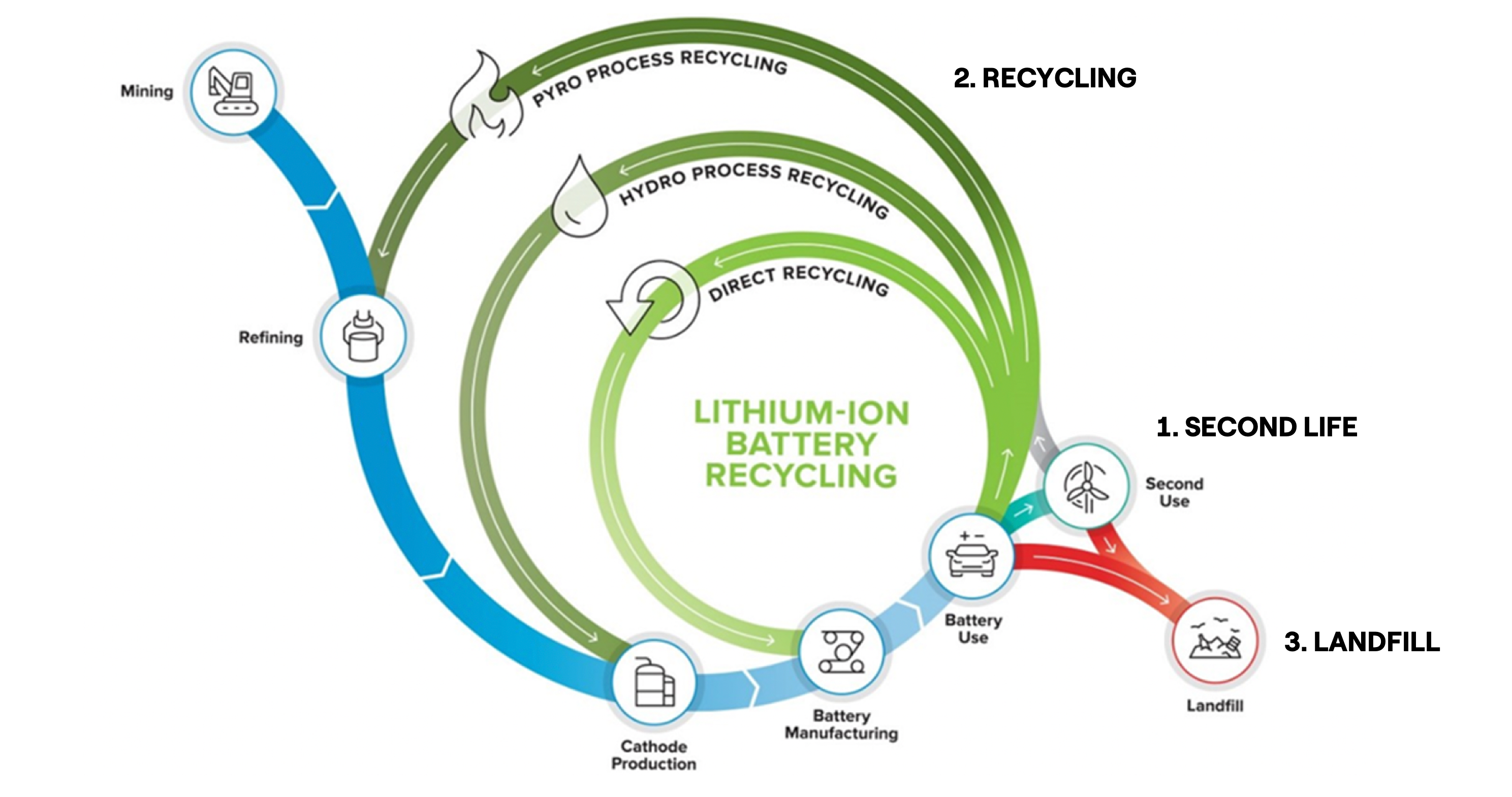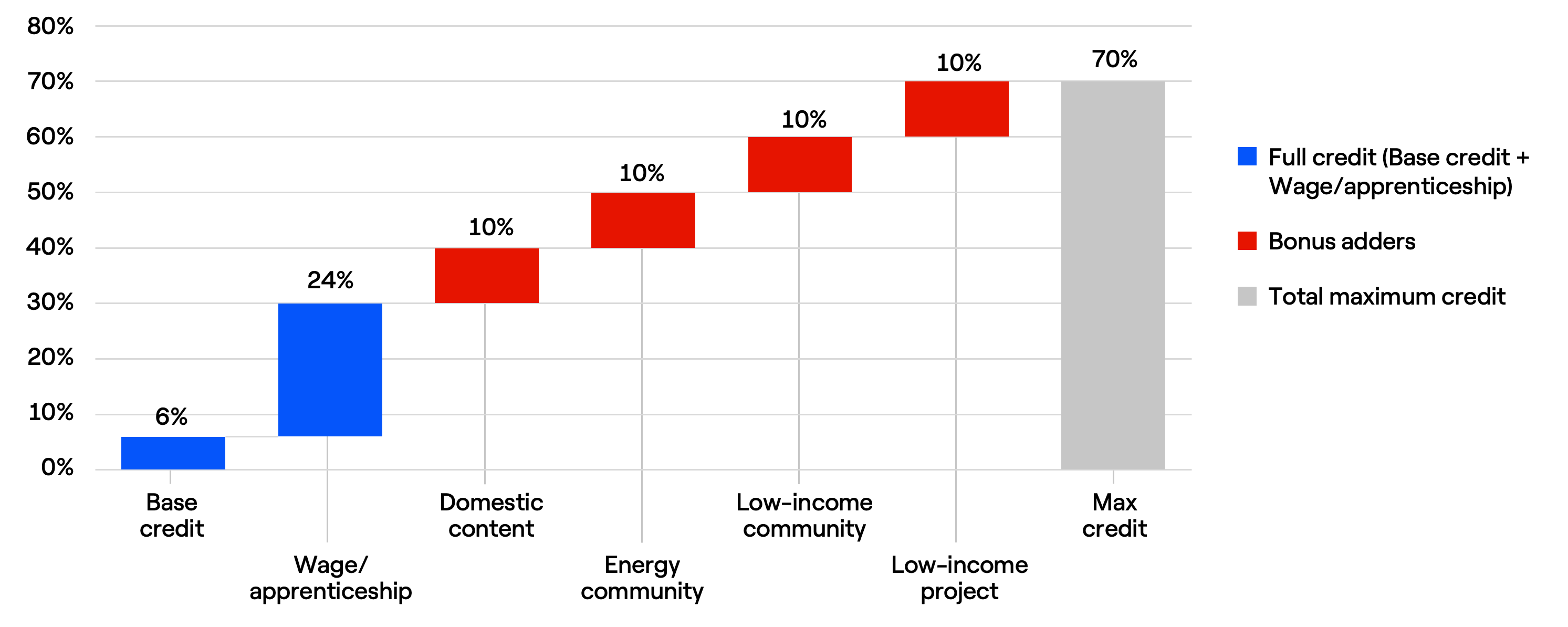06 05, 2023
{{ content.title }}
{{ content.description }}
Growing demand for renewable energy, an aging electrical grid, costly grid infrastructure improvements, and increasing extreme weather events will require increased energy flexibility to help the grid balance intermittent supply with responsive demand. Energy storage systems – like battery storage – are ideal candidates for providing this flexibility. In addition, these systems offer a wide range of benefits to energy users. In this blog, find out what battery storage is and what value it can add to your organization.
What is energy storage?
At its core, energy storage unlocks energy flexibility, allowing it to play a critical role in balancing electricity supply and demand, making the electrical grid more reliable and cleaner. Energy storage systems can store surplus energy and dispatch flexible capacity to support the electrical grid during peaks of energy demand, such as when temperatures are high, or when intense weather events and power outages occur.
There are four basic types of energy storage:
- Electrochemical systems – e.g., lithium-ion batteries and flow batteries
- Thermal systems – e.g., storing heat in rocks
- Mechanical systems – e.g., pumped hydro, compressed air, and gravity-based storage
- Chemical systems – e.g., capacitors and hydrogen storage
What is battery storage?
Although over 90% of the world’s energy storage capacity is still pumped hydro storage, battery storage is catching up, accounting for the majority of new storage capacity installed. Lithium-ion batteries, in particular, are favored for their high energy efficiency, density, and long cycle life.
There are some key characteristics of battery storage:
- Discharge capacity – the maximum instantaneous discharge power, measured in kilowatts (kW)
- Storage capacity – the maximum energy that can be stored in the “tank”, measured in kilowatt-hours (kWh)
- Duration – the ratio of storage capacity to discharge capacity, measured in hours, equivalent to how long the system can deliver maximum power for, assuming it started from a full charge
Most commercially deployed battery energy storage systems have storage durations of two to four hours, used for short-duration applications like ancillary services and shaving demand peaks. As the grid further decarbonizes and balancing intermittent energy resources like solar and wind become more critical to the transition to a decarbonized grid, the use of longer duration energy storage systems may be warranted.
While lithium-ion batteries can discharge for a long time, a sweet spot is around two to four hours, based on the economics. For longer duration applications, alternative technologies may be required.

This is a mockup of an Enel innovation project: a gravitational energy storage system, which integrates Enel’s recycling of decommissioned wind turbine blades into the weights used by Energy Vault’s gravity-based energy storage system.
What services can battery storage provide?
Because battery storage is flexible – meaning it can spin up and ramp up quickly – it can provide a wide range of services to keep the grid in balance. It can also enable your organization to be more flexible in its energy usage and generate revenue from a variety of value streams. Below we describe the main services that battery storage provides to three stakeholder groups: energy markets, utilities, and customers – per RMI’s framework introduced in The Economics of Battery Energy Storage.
The economics of battery energy storage

Source: The Economics of Battery Energy Storage
- Energy market services – battery energy storage systems, because of their fast response capabilities, can provide various energy flexibility services to the grid while unlocking revenue opportunities for organizations. Grid operators and utilities are increasingly monetizing the type of energy flexibility they need to keep the grid in balance, through resources like ancillary service programs – i.e., services that help maintain a reliable electrical grid. Other services that support the grid include energy arbitrage, voltage support, and black start capabilities.
- Utility services – battery energy storage systems can also substitute for the need for expensive grid infrastructure upgrades, through services like distribution and transmission investment deferral, congestion relief, and providing for local resource adequacy.
- Customer services – behind-the-meter battery energy storage systems (i.e., systems installed at an organization’s premises for use on-site) can help energy users manage when and how they use power at their facilities. This flexible energy usage enables organizations to reduce their energy bills and, when applicable, maximize their consumption of renewable energy when solar and battery storage are paired. There’s also a growing need for on-site backup power, which batteries – when paired with backup controls – can provide.
What do you mean when you say “distributed battery storage”?
Distributed energy resources (DERs) refer to the smaller energy generation and storage systems located on the consumer’s side of the meter for use on-site (i.e., behind-the-meter). They are typically connected to the lower-voltage distribution network, hence the name “distributed.” Distributed battery energy storage systems have different applications than the utility-scale storage systems that are typically located front-of-meter on the transmission network. Distributed applications pertain to the “customer services” stakeholder group mentioned in the previous question. In the remainder of these questions, we focus on these battery energy storage systems located on the consumer side of the meter, and omit “distributed” for brevity.
What are the benefits of battery storage for my organization?
The main benefit is energy cost savings. Energy-intensive industries spend a large percentage of their operational budget on their energy bills, every year. In addition, increased pressure to decarbonize from both regulators and stakeholders are driving the need for organizations to more holistically assess how and when they are consuming electricity from the grid. When optimized for your facility’s consumption pattern and utility tariff, battery storage can help you charge and store excess energy when prices are low and switch your consumption to the stored energy when prices are high.
Three main ways battery storage unlocks energy cost savings
From demand charge management (both when the grid is at its peak and when the facility is at its peak), time-of-use energy arbitrage, and, when applicable, revenues for providing grid services like demand response

There are even more benefits by pairing solar and battery storage

There’s also a growing need for on-site backup power, which battery storage, when paired with backup controls, can serve to provide. For example, Enel completed in 2022 a solar + storage microgrid at Alltown Fresh service station in Ayer, Massachusetts to support continuous power for service stations near evacuation routes across the state during emergencies. By integrating the system behind the same meter, on-site solar power will help charge electric vehicles (EVs). During a grid outage, the facility’s critical loads can continue to be powered.
Can I purchase a battery energy storage system and operate it myself?
Probably not. There are two main components to installing a battery energy storage system at your facility. The first is the technology piece, which includes both the hardware and optimization software. Similar to a GPS navigator guiding you home, the optimization software is what analyzes information in real-time to determine optimal operation of your system – like when and how much to charge and discharge at any point in time.
The second is the operation of the hardware and optimization software to maximize the system’s value. You could capture some value by operating the system according to a set of simple rules. However, capturing the full value of a battery energy storage system requires tapping into multiple value streams, sometimes simultaneously, such as:
- Shaving demand peaks to generate energy bill savings
- Providing grid services like energy flexibility
- Applying for investment benefits (in some regions)
Capitalizing on all available value streams requires specific knowledge and expertise about using and constantly updating the optimization software, accessing wholesale energy markets, and maintaining real-time dynamic tariff libraries to unlock this full stack of value. Therefore, we recommend that organizations work with a trusted energy partner, like Enel, who can interface with the complex market dynamics and diverse set of stakeholders like grid operators, utilities, and government agencies. Enel has more than 20 years of experience in this department.
My organization doesn’t have upfront capital for battery storage – what are my options?
For certain projects, Enel can help finance for you. Enel makes this possible through flexible financing options, which are different variations on a benefit-share agreement. Under such an agreement, Enel puts up the upfront capital cost for the battery energy storage system – meaning that your organization can retain your capital on your core operations, while still benefiting from battery storage. Through the life of the contract, you split the benefits (energy bill savings and grid revenues) with Enel, according to a pre-determined split.
As a result, your organization shares in the value created by the battery energy storage system, with no downside risk. Enel recoups its original investment with its split of the generated value. This zero-capex financing model is only made possible through Enel’s ability to underwrite future (uncertain but predictable) value streams. At Enel, we are confident in our ability to deliver on the full value of battery storage – and you can rest assured that through our partnership, we have aligned incentives to drive optimal performance for the system.
Zero-capex financing for battery storage

How safe is lithium-ion battery storage?
Lithium-ion battery storage has a great safety record. Tesla, a top energy storage system integrator worldwide, with more than 15 GWh of installed global capacity (as of 2022), has had only three confirmed fires. None of these incidents were behind-the-meter systems that require more stringent safety standards. Based on investigation reports, these incidents were primarily caused by improper installation of the system, meaning that these risks can be entirely mitigated through proper installation and maintenance.
At Enel, we adhere to the strictest industry standards of safety:
- System design and full-scale fire testing (UL 9540 and 9540A)
- Installation standards (NFPA 855)
Beyond what industry standards require, we strive to work out of the box in the development and sharing of best practices, both internally and externally:
- Annual summit with key prime contractors to inform and share best practices
- ISO 45001 certification for our battery energy storage system research and development lab in Spokane, Washington
- Battery Management System (BMS) and internal sensors
- Environmental controls (e.g., storm water prevention plans, risk mitigation plans)
- Electrical protection (e.g., over current fusing and circuit breakers)
- Physical protection (e.g., bollards, fencing, locked enclosures, signage)
Our battery units are housed in containers, connected to the electrical grid, and safeguarded by advanced safety features, which are monitored 24/7 digitally and remotely for safe operation. Throughout the development and construction of our battery energy storage projects, we work closely with local fire departments to meet the safety requirements in our communities. Enel is a party to fire safety standards such as NFPA 855 (a member from Enel sits on the committee) and a member of the Energy Storage Association. We’ve also signed the Energy Storage Association’s Corporate Responsibility Pledge, further demonstrating our commitment to safety when deploying energy storage resources.
What happens when the batteries reach end of life? Are they recycled?
That is what we strive for. A battery energy storage system is composed of a container, batteries, a power conversion system, HVAC thermal management, fire suppression system, and other system controls and communications. At their end of life, systems are collected, sorted, and disassembled. While most of the system components can be recycled through direct processes (like for scrap metal and electronics), the battery modules require special treatment for the processing and recycling of lithium-ion batteries.
Depending on the chemistries used in the lithium-ion batteries, there are different processes for extracting and reusing the raw materials. At a high level, waste batteries are mechanically crushed, dried, and sieved into what is referred to as a “black mass.” Precious metals are then extracted from the black mass through pyrometallurgy and hydrometallurgy:
- Pyrometallurgy – heat-based extraction and purification, in which the separation of metals is achieved through smelting in furnaces at temperatures between 1,200°C and 1,600°C. Through smelting, precious metals like cobalt and nickel can be recycled. Lithium and manganese are not recovered, because it is not economically feasible.
- Hydrometallurgy – a water-based process, in which the metals are recovered and dissolved as salt in successive water-based concentration and purification steps.
In evaluating these processes, it’s important to consider their environmental and resource impacts. Many studies have found that hydrometallurgy is a more suitable recycling method than pyrometallurgy, as it allows for a higher recovery of precious metals with lower energy consumption, greenhouse gas emissions, minimal air emissions, and purification. However, this may change as new technologies and improvements become economically viable.
Sustainability and circularity for battery storage

Looking ahead, Enel is committed to best practices for sustainability and circularity. At the system’s end of life, we will work with our suppliers to pursue the most sustainable recycling or repurposing applications.
What is the Inflation Reduction Act tax credit for battery storage?
A long-awaited win in the Inflation Reduction Act of 2022 is the new eligibility of standalone energy storage for the 30% full credit investment tax credit (ITC). Previously, standalone energy storage systems had to be attached to a solar PV or wind system to be eligible for the upfront investment incentives, and they had to charge from that system 75% of the time. Now that standalone energy storage qualifies for the ITC, these requirements are no longer necessary to qualify for the incentive.
This gives energy storage projects, like lithium-ion batteries, more siting and operational flexibility – as well as the ability to capture additional value streams like energy arbitrage, ancillary services, grid stability services, and more. Beyond the 30% full credit, there are opportunities to layer on bonus tax credits for meeting certain requirements on domestic content, energy communities, and low-income communities. Learn more about how to make the most of the Inflation Reduction Act tax credits.
Investment tax credit (ITC) potential

Is battery storage right for my organization?
You may be a good candidate – but a feasibility study is needed. Battery storage can be a good fit for organizations that want to reduce their energy costs, improve energy resilience, and reduce their carbon footprint. However, the specific benefits and costs will depend on several factors, including your energy usage, location, and project complexity. It is recommended that you first conduct a feasibility study to determine if battery storage is the right fit.
Industries that have high energy costs (due to energy usage or high tariffs) are good candidates for battery storage. Industries that fall into this category include commercial real estate, industrial manufacturing, data centers, governments, and schools. Battery storage is particularly well-suited for industries that operate during peak demand periods, as it can help reduce peak demand charges.
Location is also important – states like California, Massachusetts, Connecticut, and New York have storage-specific incentive programs. These incentives can help offset the initial cost of purchasing and installing a battery energy storage system. It is important to identify all potential value streams to see if a project at your site will make economic sense. Contact our team today for a tailored battery storage strategy and to find out how much value you can unlock by installing a system at your site.